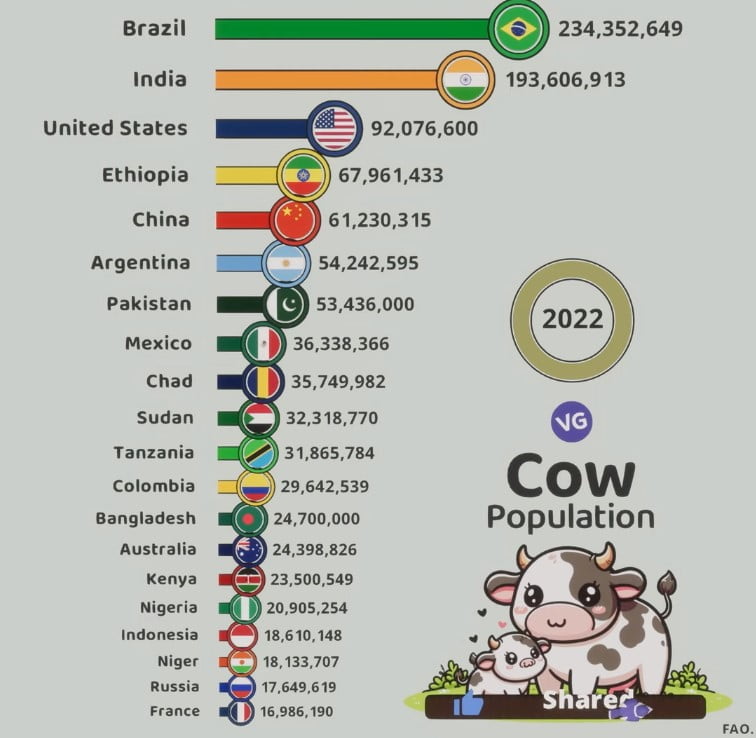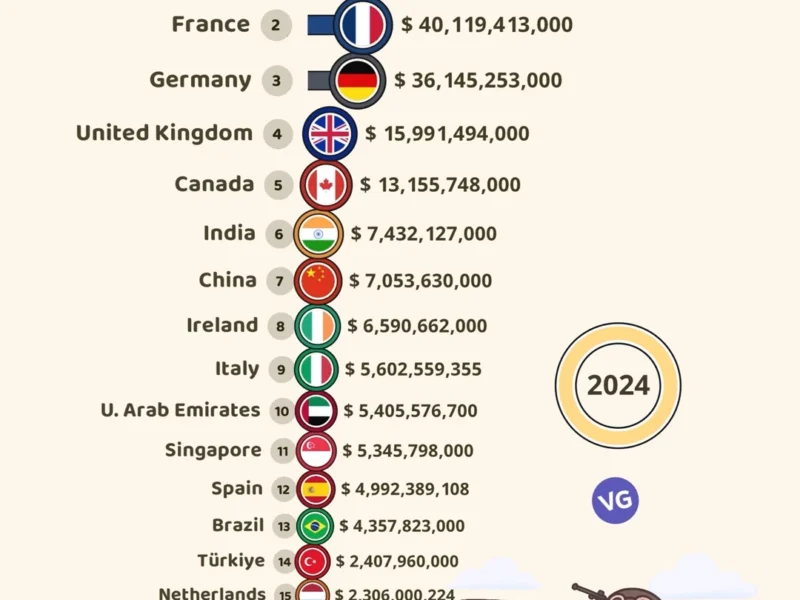Ever wonder which countries have the most cows? The beef industry worldwide is both complex and fascinating. Certain nations are truly at the forefront of cattle breeding.
According to the USA, India leads with a whopping 301.6 million cows.1 In India, cows are sacred and protected by law. Brazil follows with 219 million cows,1 and China is third with 100.2 million. The United States has 91.8 million, and the European Union has 88.6 million cows.2
| Rank | Country | Flag | Cow Population (2022) |
|---|---|---|---|
| 1 | Brazil | 🇧🇷 | 234,352,649 |
| 2 | India | 🇮🇳 | 193,606,913 |
| 3 | United States | 🇺🇸 | 92,076,600 |
| 4 | Ethiopia | 🇪🇹 | 67,961,433 |
| 5 | China | 🇨🇳 | 61,230,315 |
| 6 | Argentina | 🇦🇷 | 54,242,595 |
| 7 | Pakistan | 🇵🇰 | 53,436,000 |
| 8 | Mexico | 🇲🇽 | 36,338,366 |
| 9 | Chad | 🇹🇩 | 35,749,982 |
| 10 | Sudan | 🇸🇩 | 32,318,770 |
| 11 | Tanzania | 🇹🇿 | 31,865,784 |
| 12 | Colombia | 🇨🇴 | 29,642,539 |
| 13 | Bangladesh | 🇧🇩 | 24,700,000 |
| 14 | Australia | 🇦🇺 | 24,398,826 |
| 15 | Kenya | 🇰🇪 | 23,500,549 |
| 16 | Nigeria | 🇳🇬 | 20,905,254 |
| 17 | Indonesia | 🇮🇩 | 18,610,148 |
| 18 | Niger | 🇳🇪 | 18,133,707 |
| 19 | Russia | 🇷🇺 | 17,649,619 |
| 20 | France | 🇫🇷 | 16,986,190 |
The top cattle countries range beyond these leaders, including Argentina with 51.99 million cows,2 and Australia with 26.15 million,2. Russia has 18.66 million,2 and Mexico 16.45 million.2 Uruguay adds 12.06 million cows to this. The role these countries play in beef production is pivotal. What made them so successful in cattle farming, and how do they meet the global demand for beef? Let’s find out more.
Key Takeaways
- India has the largest cattle population in the world, with over 301.6 million cows.
- Brazil is the second-largest country in terms of cattle herd, with 219 million cows.
- The United States, China, and the European Union also rank among the top countries with the most cows.
- Argentina, Australia, Russia, Mexico, and Uruguay are other major cattle-producing nations.
- The size and distribution of cattle herds around the world are influenced by various factors, including cultural, economic, and environmental considerations.
India: The Cow-Revering Nation with the Largest Herd
India is famous for valuing cows more than any other place in the world.3 Its rich history and culture have led to a special kind of society. Here, cows are not just animals. They are sacred and protected by law.
Sacred Status and Legal Protection of Cows
In India, cows hold a special place in the hearts of many.3 This belief comes from the teachings of Hinduism. The government has laws to keep cows safe from harm or being killed.4
Massive Population of 301.6 Million Cows
India shows its love for cows through a huge number. 301.6 million cows live there.3 This count is about a third of all cows in the world. It shows how important cows are to Indian life.3
Historical and Cultural Significance of Cows
India’s respect for cows has a long history. Cows are part of ancient stories, religious texts, and spiritual practices.3 These stories go back more than 2,500 years. They show how central cows have always been to India. This care has shaped modern India, where cows are looked after carefully. They are key to the country’s society and economy.
Brazil: The Beef Powerhouse with 219 Million Cattle
Brazil ranks second in the world for its large cattle population, having 219 million cows.5 It has a thriving beef industry that uses its vast natural pastures and resources. This allows for a big cattle herd.5
A Robust Beef Industry with Abundant Resources
In 2017, Mato Grosso, a state in Brazil, had 30.2 million cows.6 Since 1960, Brazil’s farming has become very modern. This modernization is key to its agricultural success.5 Different regions within Brazil, like Mato Grosso, Rio Grande do Sul, and São Paulo, each have their own farming features.5
Technological Advancements and Agricultural Practices
Brazil is committed to using the latest technology and farming methods to make its beef better.5 From 1967 to 2016, 133 processing plants opened and closed in Mato Grosso.6 By 2016, there were 72 plants, run by 52 companies, in operation in the state.6 The number of plants in Mato Grosso increased by 29% from 2000 to 2016.6 There were three main growth times: 1967–1995 with 15.1% growth, 1996–2003 with 24.6%, and 2004–2016 with 60.3% of the plants.6
This growth makes Brazil not just a big meat producer, but a top meat exporter in the world too.5
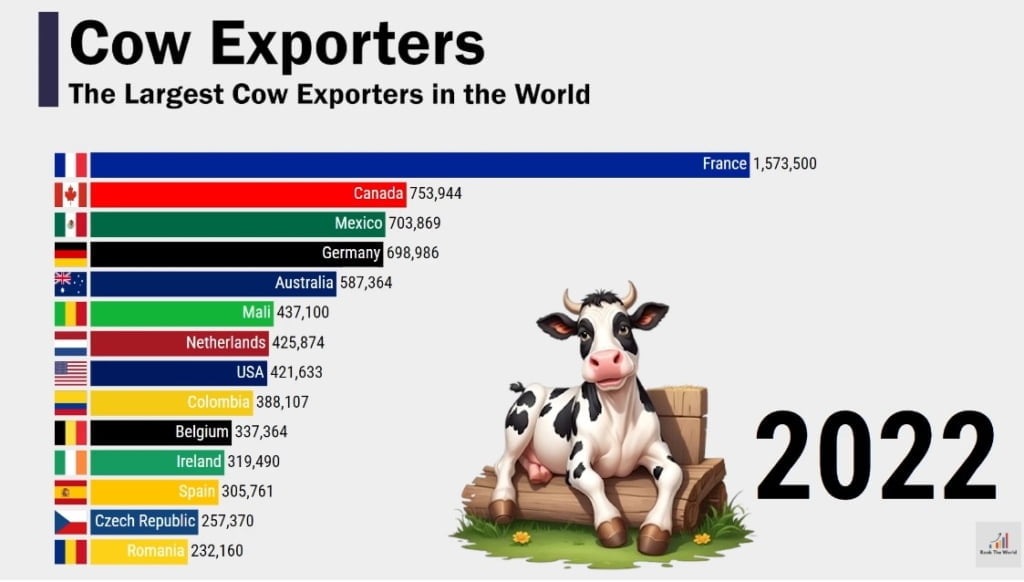
China: The Rapidly Growing Beef Consumer and Producer
China ranks as the world’s third-largest beef producer. It had a whopping 98.17 million head of cattle in 2022.2 This surge in beef production is mainly due to more people eating meat. This trend is fueled by an increase in China’s population and a shift towards eating more animal proteins.7
The World’s Third-Largest Cattle Inventory
China is among the top three beef producers globally.7 It stands out as the biggest beef producer in Asia. With over 98 million cattle, it holds the world’s third-largest stock.27 Notably, China’s beef output is on the rise. This growth makes it a key player both in producing and consuming beef.8
Rising Demand for Beef in China’s Dietary Shift
The Chinese are eating more beef per person than before.7 In response, China has increased its beef production significantly. Today, it plays a major role in the global beef market.7 Over the last 20 years, China has doubled its beef output. The number of cows slaughtered each year has jumped from 26.86 million to 50.50 million.7 During the same period, the percentage of cows used for beef rose from 24.4% to 50.46%.7
In China, key provinces like Hebei, Shandong, and Inner Mongolia lead beef production.8 These provinces, along with other regions, drive China’s beef industry forward. This uptick mirrors China’s changing eating habits, making it a significant player in global beef markets.
The United States: Leading the Way in Beef Production
In 2022, the United States produced 12.89 million tons of beef. It has a cattle herd of 92.08 million.9 The US beef industry is known for its top-notch supply chain and global reach. It also has a highly efficient cattle farming system.10
Efficient Supply Chain and Global Presence
The US beef industry is at the top due to its efficient supply chain.10 It comes in second in beef exports, after Brazil. Home beef production mainly influences its export levels.10
Highly Productive Cattle Industry
Although the US cattle herd was at its highest in 2019 at 94.8 million, it’s now 89.3 million head strong by 2023.10 Yet, this drop hasn’t reduced its efficiency. For instance, farms with over 100 cows make up nearly 10% but supply more than half the beef.10 Big feedlots, though only a small part, handle most of the cattle. The largest ones deal with about 40% of the slaughtering cattle.10
Innovative Farming and Processing Techniques
The US beef sector uses the latest in farming and processing to keep ahead globally.10 It focuses on grain-fed beef sales, which are higher priced. This strategy matches the preferences of its biggest market, itself.10 The sector is set to account for about 17% of the earnings from all farm goods in 2023.10
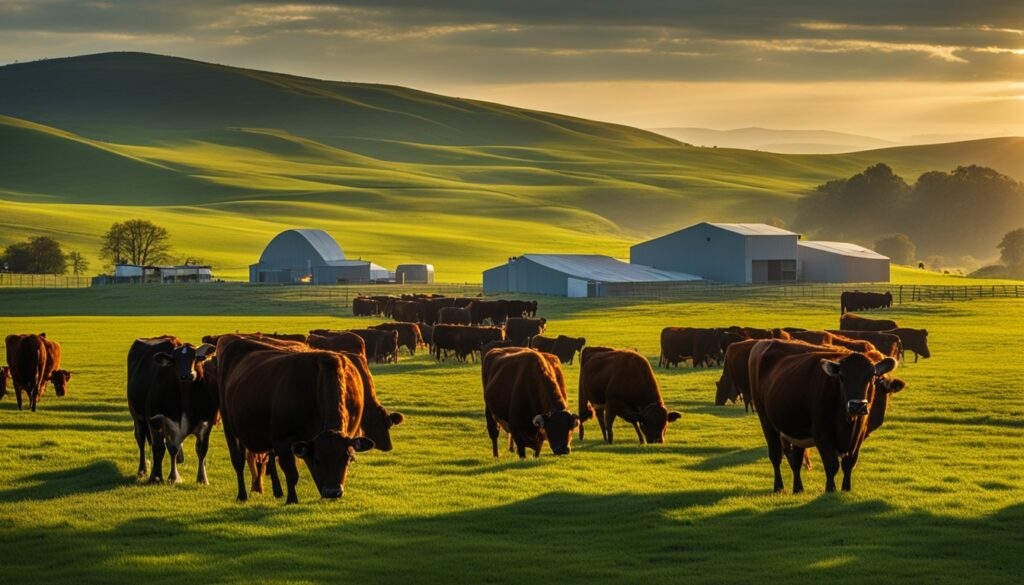
The Countries with the Most Cows in the World
Besides the top beef producers, Argentina and Australia have lots of cows. Argentina boasts over 53.4 million cattle2. It’s key in the beef export world thanks to its huge livestock and efficient methods. Meanwhile, Australia uses its large natural pastures and trade deals to shine in beef export. It has about 23.04 million cattle2.
Argentina: A Major Player in Beef Exports
In 2022, Argentina ranked fifth in beef production worldwide. It made 3.14 million tons of beef from its 53.4 million cattle2. Thanks to its big cattle stock and smart ways of working, Argentina is a major exporter. It helps the beef export market grow, more beef companies will join it.
Australia: Capitalizing on Natural Pastures and Trade Agreements
Australia is the seventh top beef producer in the world. It produced 1.88 million tons of beef with its 23.04 million cattle in 20222. The [Australia cattle industry] benefits from its huge natural pastures and trade deals. This has helped Australia become a top place for beef exports worldwide.
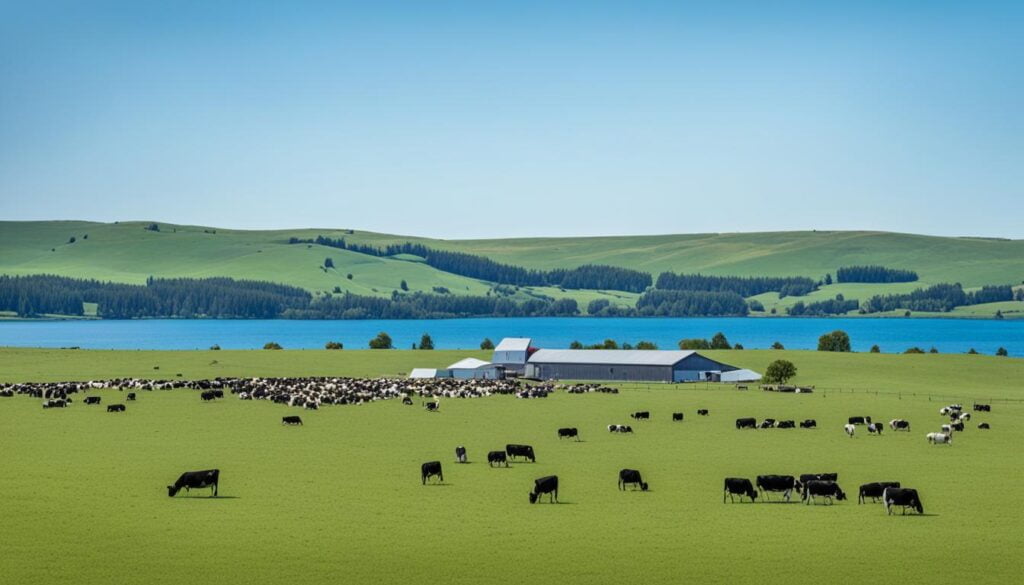
Emerging Beef Producers and Their Contributions
Emerging beef producers are growing in the global market. Mexico, for instance, has a big impact. It has a large amount of cattle and a strong local market.
This makes Mexico beef production and Mexico beef consumption grow.2 This growth is key in the beef industry.
France: A Significant European Beef Producer
France is a major player in the France beef industry in Europe. It’s famous for high-quality meat. The country focuses on letting their cattle roam and graze. This leads to deluxe beef products.
With 17.4 million cattle, they’re a top producer.2 Their methods stand out in the beef sector.
Canada: Quality Meat and Export Potential
Canada is known for its quality beef. It has 11.51 million cattle. They are growing their industry and aiming to export more beef.
Canada is increasing beef production. They are also getting more involved in global trade.2
These newcomers are finding their place in the beef market. They use what makes them special to grow. This is helping the beef industry worldwide to become diverse and more robust.
Russia: Investing in Beef Production Infrastructure
Russia is stepping up in the beef industry, staying competitive with top producers. It has a big cattle herd of 17.79 million.2 This investment aims to grow its role in the world beef market.
Expanding Cattle Herd and Technological Advancements
The Russian government is working hard to grow its cattle herd. It uses new technologies to make beef production better.11 By 2018, Russia aims to produce 1.3 million metric tons of beef.
Even though the cattle number will drop to 18.3 million in 2018,11 these efforts show Russia’s interest in the global market.
Miratorg leads these advancements in Russia.12 Their big processing plant and feedyards are a huge part of this. Miratorg’s cattle already meets high-quality standards.
The cattle industry faces hardships, especially from drought.12 Yet, Russia stays dedicated to boosting its beef production. It wants to offer better quality beef and play a bigger part in the global market.
The Global Beef Market: Meeting the Demand for Protein
Beef is key in the world’s food supply. It’s a rich protein source for many people worldwide. The need for beef is growing, thanks to more people and their eating habits.10,13
Culinary Versatility and Cultural Significance of Beef
In many cultures, beef is a must-have. It brings a variety of flavors and dishes to the table. From juicy steaks to filling stews, there’s a beef dish for every taste.
This worldwide demand keeps the beef market lively. Everywhere, it’s a top choice for protein-rich meals.
Economic Impact of Beef Production and Trade
Beef helps many economies, creating jobs and balancing trade. In the U.S., beef cattle make up a big part of farm earnings. And the U.S. is a leader in producing and consuming beef, especially the high-quality kind.10
Lately, places like Indonesia have seen a jump in beef need, thanks to their growing economy. Near them, countries in the Asian Economic Community are set to buy more beef. This will make them big players in the beef market of Southeast Asia.13
Efforts are on to keep up with the world’s protein demands while respecting cultural traditions. This approach has made the beef market an essential part of the global economy.
Conclusion
The biggest beef producers are in different continents like Latin America, Asia, Europe, and Oceania.14 The United States, Brazil, and China lead in beef production and trade.7,15 The beef industry grows because more people want protein. It also helps the economy.7,15 With more people and new food choices, beef remains important for many.
The number of cows worldwide has been growing for over 60 years. There are about 1.5 billion cows according to FAO.14 However, counting cows is hard, especially in places like Africa.14 Despite this, the beef industry’s economic effect and its role in feeding the world are major points.
The top beef producers are improving their technology, supply chains, and how they take care of the environment.7,15 This shows the beef industry is ready to change and keep up with food needs. As it progresses, it will aim to meet high protein demands responsibly and with respect for culture.15
FAQ
What country has the largest cow population in the world?
The United States Department of Agriculture (USDA) states that India leads in cow numbers. It has 301.6 million cows.
Which country is the second-largest in terms of cow population?
Brazil follows, being the second-largest, with a count of 219 million cows.
What is the total cow population in the world?
The world has about 987 million cows. India, Brazil, China, the United States, and the European Union top the list.
Why are cows considered sacred in India?
In India, cows are held in high regard and are protected by law. They have been sacred for more than 2,500 years. In Indian culture, hurting or killing cows for food is not done.
How does Brazil’s beef industry contribute to its large cow population?
Brazil’s vast natural resources allow for a big beef industry. It uses natural pastures well. Technology and better farming methods also help its beef production.
What is the role of the United States in the global beef market?
The U.S. leads as the biggest beef producer in the world. It made 12.89 million tons in 2022 with 92.08 million cows. Its beef production is known for being efficient and productive, thanks to advanced techniques and processes.
Which other countries have significant cattle populations?
Besides the top producers, countries like Argentina, Australia, Mexico, and Russia have lots of cows too. For example, Argentina has 53.4 million, and Australia has 23.04 million.
What is the economic and cultural significance of the global beef industry?
Beef is important in diets globally and is culturally valued. It provides jobs and helps a lot in trade for many nations. The beef industry grows to meet protein demands and cultural needs.
Source Links
- https://www.fool.com/investing/general/2014/09/21/youll-never-guess-which-country-has-the-most-cows.aspx
- https://ruminants.ceva.pro/beef-producing-countries
- https://www.ncbi.nlm.nih.gov/pmc/articles/PMC8388465/
- https://www.washingtonpost.com/world/2018/07/16/amp-stories/why-india-has-million-stray-cows-roaming-country/
- https://www.cambridge.org/core/books/feeding-the-world/new-agricultural-economy-post-1960/2CCF3DEBC1561DF99507FF19333EC0B1
- https://journals.plos.org/plosone/article?id=10.1371/journal.pone.0215286
- https://www.ncbi.nlm.nih.gov/pmc/articles/PMC6039324/
- https://projectblue.blob.core.windows.net/media/Default/What we do/Exports/ChinaBeefReport_200617_WEB.pdf
- https://www.meatloaf.pro/the-40-countries-that-produce-the-most-beef/
- https://www.ers.usda.gov/topics/animal-products/cattle-beef/sector-at-a-glance/
- https://apps.fas.usda.gov/newgainapi/api/report/downloadreportbyfilename?filename=Livestock and Products Annual_Moscow_Russian Federation_11-28-2017.pdf
- https://cabcattle.com/news-release-starting-with-the-best-in-russia/
- https://www.ncbi.nlm.nih.gov/pmc/articles/PMC6039325/
- https://cairncrestfarm.com/blogs/blog/how-many-cows-are-there-in-the-world
- https://www.fb.org/market-intel/u-s-cattle-inventory-smallest-in-73-years

